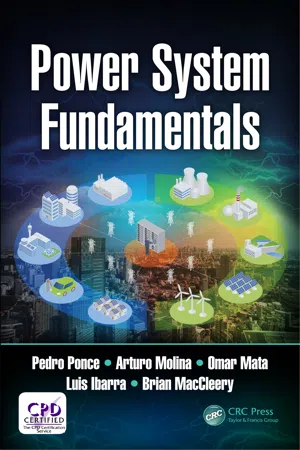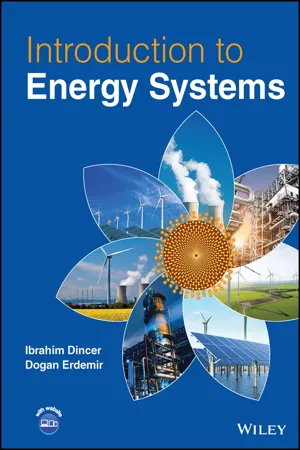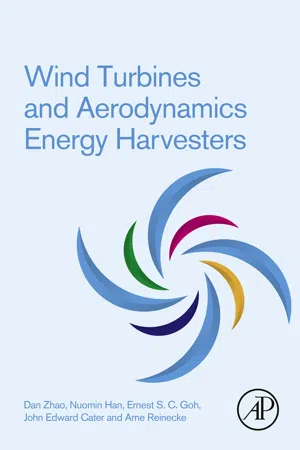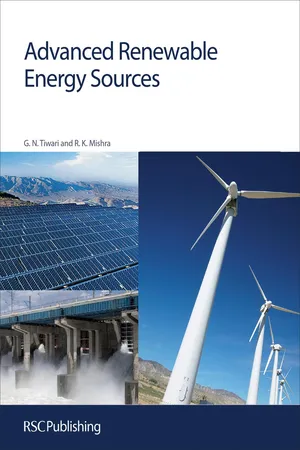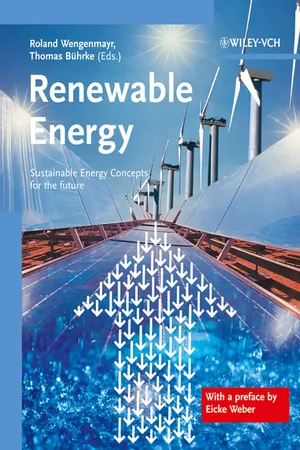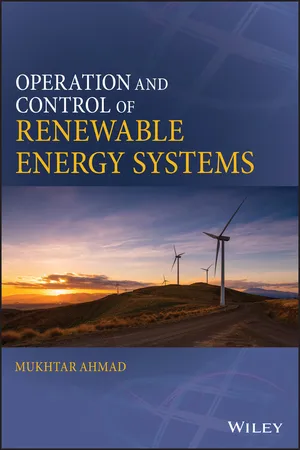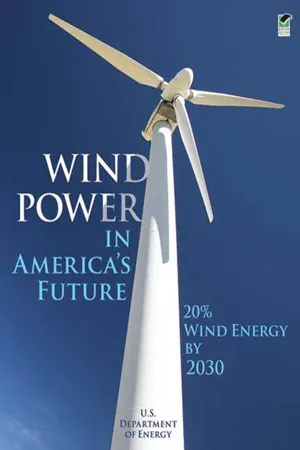Technology & Engineering
Wind Turbine
A wind turbine is a device that converts the kinetic energy of the wind into mechanical energy, which is then used to generate electricity. It typically consists of large blades mounted on a tall tower, and as the wind causes the blades to rotate, the kinetic energy is transformed into electrical power through a generator. Wind turbines are a key technology for harnessing renewable energy.
Written by Perlego with AI-assistance
Related key terms
7 Key excerpts on "Wind Turbine"
- eBook - ePub
- Pedro Ponce, Arturo Molina, Omar Mata, Luis Ibarra, Brian MacCleery(Authors)
- 2017(Publication Date)
- CRC Press(Publisher)
4Wind Energy
Wind energy has been exploited for thousands of years. Its principal ancient applications are extracting water from wells, cutting lumber, grinding grain for making flour, and other mechanical power applications. Nowadays wind is employed mostly for electric power generation. Wind generators are also called Wind Turbines, because their function is similar to the gas and steam turbines that are used for electric energy generation. Since the end of the nineteenth century, attempts at electric generation from wind power have been made; nevertheless, combustion-based turbines had much greater development and applications due to their higher reliability and the possibility of being used whenever necessary. Due to oil crises in the 1970s, wind energy has been growing and has been the subject of major investment in Europe and North America, and more recently, in China. In the 1980s, the power electronics technology and aerodynamics of Wind Turbines were sufficiently mature to begin large-scale manufacturing of Wind Turbines for commercial use. Today, wind energy is one of the most cost-effective methods of electricity generation and it is the most important in terms of power capacity installed as a renewable energy source.4.1 Wind Turbine basic structureA Wind Turbine is a device that transforms the kinetic energy coming from the air stream into electrical energy; this conversion requires a mechanical step and then an electrical one. The element that extracts the energy from the wind is the rotor, and the rotor drives the electrical machine, usually through a gearbox. After that, the generator converts the mechanical power into electrical power.Many designs of Wind Turbines have been developed over the years. Here we are not studying the historical survey of the wind conversion systems, but an interesting resume can be found in [11 ]. Basically there are two configurations: vertical axis and horizontal axis Wind Turbines, the latter ones being more popular due to their better efficiency. Today for onshore and offshore applications almost all of the manufactured turbines are horizontal axis with two or three blades. Figure 4.1 - eBook - ePub
- Ibrahim Dinçer, Dogan Erdemir(Authors)
- 2023(Publication Date)
- Wiley(Publisher)
Major landforms can accelerate wind, resulting in some regions being very windy while others remain relatively calm. By converting wind power into electricity, wind power can be transported over long distances, serving the needs of urban centers with large populations. One of the fastest-growing renewable energy sources in the world is wind energy. Technology developments, environmental concerns, and the continuous increase in conventional energy use have led to a reduction in relative wind energy costs in many locations to economically acceptable levels as a result of concerns over fossil fuel demand. As a result, many jurisdictions are considering wind energy farms as an alternative energy source because they have been installed and operating for more than 25 years. Electricity is produced by Wind Turbines by converting the kinetic energy of the wind to shaft power. The shaft power is transmitted to the generator by transmission. Figure 7.7 demonstrates the wind power generation mechanism. Modern large-scale Wind Turbines convert wind kinetic energy into rotational motion by mounting a rotor on which the device to catch the wind is mounted. Wind Turbines usually have a three-bladed assembly at the front, but other geometries and types are also available. Wind Turbines have a rotor that spins a shaft, which transfers motion to the nacelle. A gearbox inside the nacelle increases the rotational speed of the slowly rotating shaft. Several hundred volts of electricity are generated by converting the rotational motion of the output shaft into electricity at a medium voltage. A transformer (a few thousand volts) increases the voltage of the electric power to a level more appropriate for distribution (a few thousand volts) by passing it through heavy electric cables inside the tower. By using higher voltage electricity, fewer power losses and less heat will be generated through electric lines as a result of fewer resistances - eBook - ePub
- Dan Zhao, Nuomin Han, Ernest Goh, John Cater, Arne Reinecke(Authors)
- 2019(Publication Date)
- Academic Press(Publisher)
available in the blade swept area is determined as the rate of change of the wind kinetic energy:=w ̇available=ddtmV 2/ 2=ρA2V 32Air densityDisk / swept areaWind speed 3(1.1)It is apparent that the available wind power is proportional to the swept/disk area and also proportional to the cube of the wind speed. Doubling the wind speed (for example choosing a region where the turbine can be exposed to higher-speed wind) or the turbine blade diameter will lead to 8 or 4 times as much available wind power.Additionally, wind power density is another comprehensive index to evaluate various Wind Turbines at different locations for comparison. It is the available wind power in moving air through a unit area of perpendicular cross-sectional plane within a period [8] as defined in Eq. (1.2) with a unit of W/m2 . It can be used to evaluate the effectiveness of wind energy harvester in utilisation of space.Wind power density =ẇ available/ A =2Air densityWind speed 3(1.2)Eq. (1.2) reveals that- (1) The wind power density is linearly proportional to the air density. Colder air has a larger wind power density than warmer air blowing at the same speed. However, this density effect is typically insignificant.
- (2) The wind power density is proportional to the cube of the wind speed. Doubling the wind speed increases the wind power density by a factor of 800%. This is the main reason why wind farms are located where wind speed is high!
- eBook - ePub
- Gopal Nath Tiwari, Rajeev Kumar Mishra(Authors)
- 2015(Publication Date)
- Royal Society of Chemistry(Publisher)
CHAPTER 7 Wind Energy7.1 INTRODUCTION
In the past, wind energy was used (i) to propel ships (ii) to produce mechanical energy for pulling up underground water from wells and (iii) grinding agriculture products. There is also evidence that suggests that the ancient Egyptians used windmills to pump water for irrigating agricultural lands and to grind grains during 3600 B.C. Wind is simply air in motion that carries kinetic energy with it. The kinetic energy is converted into first mechanical and then electrical energy by generation. The mechanical energy of wind can be used for driving ships, pumping water, grinding grains, etc.The harnessing of electrical power from wind is gaining momentum due to the depletion of fossil fuels and their rising running cost. Moreover, wind energy is considered to be a green/clean power technology. It has minor impacts on the economy and environment. Hence, wind energy, which is a renewable sources of energy, can be harnessed to provide an environmentally friendly and reliable source of energy without producing any air pollutants or greenhouse gases. The kinetic energy of wind is captured by the Wind Turbine that is mechanically coupled to an electrical generator. The turbine is mounted on a tall pillar to enhance the energy capture. In the 19th century, Wind Turbines contributed greatly to the economic development of many countries like the Netherlands, Denmark and the USA. The use of wind energy declined very fast everywhere due to the cheap availability and exploitation of coal, oil and gas resources.The old Wind Turbines were no longer economically competitive with conventional sources of energy. Therefore, very little research was done to develop new and more efficient Wind Turbines. Due to the energy crisis during 1973 the development of new and more efficient Wind Turbines was resumed to generate electricity. As a result, the cost of electricity produced by Wind Turbines decreased dramatically due to improved technology. Nowadays, the extraction of electrical power with modern turbines from the wind is an established industry. A device for direct mechanical work is often called a windmill or just Wind Turbines. If electricity is produced, the combination of turbine and generator may be called a wind generator or aerogenerator that is also referred as a wind energy-conversion system (WECS) - eBook - ePub
Renewable Energy
Sustainable Energy Concepts for the Future
- Roland Wengenmayr, Thomas Bührke, Roland Wengenmayr, Thomas Bührke(Authors)
- 2011(Publication Date)
- Wiley-VCH(Publisher)
Wind Energy A Tailwind for Sustainable Technology BY MARTIN KÜHNThe use of wind energy has experienced a rapid increase in the past fifteen years. What technologies, economic and political factors have fostered this development? Will further increases be compatible with the present system of energy supplies?By mid-year of 2007, there were more than 19 000 Wind Turbines with a total capacity of nearly 21 GW installed in Germany - and the trend is for this number to increase. Assuming an average wind year, these installations together can generate 6.9 % of the total net electricity consumption, and thus exceed the power generated in Germany today from every other renewable energy form. More than a quarter of the worldwide wind power is at present installed in Germany, but the international markets are also growing. Within the last five years, the annual newly-installed capacity increased by 17 % on average, especially in other European countries, the USA and in Asia (Figure 1 ). The German wind energy sector currently provides 74 000 jobs and exports 74 % of the turbine equipment produced; it is profiting effectively from the continuing international boom.From the Drag Device to the High Tip Speed TurbineHumans have made use of wind power for around 4000 years. Besides sailing ships, wind-driven pumps and mills were developed long ago. Early forms of windmills used a rotor with a vertical axis which was driven by the drag force exerted by the air flow passing the rotor blades. This design concept, known as a drag device, has a low efficiency, at most about one fourth of that of the lift devices described in the following [1]. Today, it is therefore used practically only in the form of the cup anemometers that measure wind speed. From around the 12th century on, new windmill types were developed, such as the post mill or Dutch windmill, which operated on the basis of a different and more effective principle. The decisive advance was not the generally horizontal orientation of the rotor axis, but rather the fact that the flowing air drives the rotor blades via the aerodynamic lift force. For a drag device, which is moving with the flow, the relative velocity at the rotor blades is always smaller than the wind speed. Lift devices, in contrast, can achieve higher apparent wind speeds by superposition of the wind speed and the circumferential velocity of the rotor. Only in this way can the forces necessary for an optimal deceleration of the wind be generated, and the aerodynamic efficiency approaches its theoretical maximum of 59 % calculated by Albert Betz and F.W. Lancaster. - Mukhtar Ahmad(Author)
- 2017(Publication Date)
- Wiley(Publisher)
Chapter 7 Wind Energy7.1 Wind as Source of Energy
The wind power is basically nothing but another form of solar energy. Approximately 1% of the total solar energy absorbed by the Earth is converted to kinetic energy in the atmosphere, in the form of wind. Since early recorded history, people have realized the potential of wind energy and utilized it for various applications. It was used to propel boats along the Nile River as early as 5000 BC, and it was used to pump water and grind grain between 500 and 900 BC. By the 11th century, windmills were used in food production in the Middle East. The windmills were further improved by the Dutch and others and were adapted for industrial applications such as sawing wood, making paper and draining lakes and marshes. In the late 19th century, the wind power was used in windmills to pump water for farms and ranches. However, due to industrialization and rural electrification, in the 20th century, there was gradual decline in the use of windmills for mechanical applications.First large-sized automatically operating Wind Turbine for generation of electricity was built by Charles Brush of the United States in 1888. From 1920 to 1940, propeller-type horizontal-axis Wind Turbines (HAWTs) with two or three blades were used to supply electricity in rural areas where supply of electricity from the grid was not available. However, the use of Wind Turbines to generate electricity at a commercial scale started in the 1970s as a result of technical advances in the field of turbine and mainly due to escalating oil prices because of OPEC crisis in 1971. During the last few years, the three-blade upwind horizontal-axis large turbines on monopole tower have become the standard. In terms of total number of Wind Turbines in use at present, they are of small capacity of the order of 10 kW or less. But in terms of total generating capacity, the turbines that are used in large wind farms have capacity in the range of 1.5–5 MW.- eBook - ePub
Wind Power in America's Future
20% Wind Energy by 2030
- U.S. Department of Energy(Author)
- 2013(Publication Date)
- Dover Publications(Publisher)
Chapter 2.
Wind Turbine Technology
Today’s wind technology has enabled wind to enter the electric power mainstream. Continued technological advancement would be required under the 20% Wind Scenario.2.1 INTRODUCTION
Current turbine technology has enabled wind energy to become a viable power source in today’s energy market. Even so, wind energy provides approximately 1% of total U.S. electricity generation. Advancements in turbine technology that have the potential to increase wind energy’s presence are currently being explored. These areas of study include reducing capital costs, increasing capacity factors, and mitigating risk through enhanced system reliability. With sufficient research, development, and demonstration (RD&D), these new advances could potentially have a significant impact on commercial product lines in the next 10 years.A good parallel to wind energy evolution can be derived from the history of the automotive industry in the United States. The large-scale production of cars began with the first Model T production run in 1910. By 1940, after 30 years of making cars and trucks in large numbers, manufacturers had produced vehicles that could reliably move people and goods across the country. Not only had the technology of the vehicle improved, but the infrastructure investment in roads and service stations made their use practical. Yet 30 years later, in 1970, one would hardly recognize the vehicles or infrastructure as the same as those in 1940. Looking at the changes in automobiles produced over that 30-year span, we see how RD&D led to the continuous infusion of modern electronics; improved combustion and manufacturing processes; and ultimately, safer, more reliable cars with higher fuel efficiency. In a functional sense, Wind Turbines now stand roughly where the U.S. automotive fleet stood in 1940. Gradual improvements have been made in the past 30 years over several generations of wind energy products. These technology advances enable today’s turbines to reliably deliver electricity to the grid at a reasonable cost.
Index pages curate the most relevant extracts from our library of academic textbooks. They’ve been created using an in-house natural language model (NLM), each adding context and meaning to key research topics.
